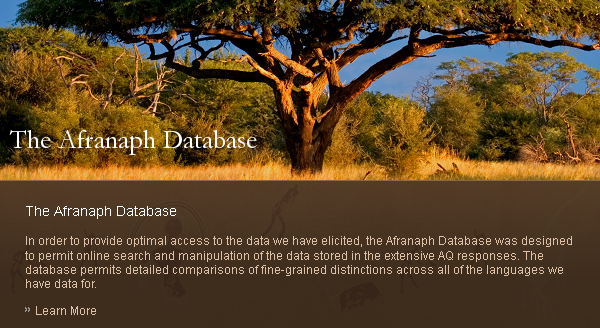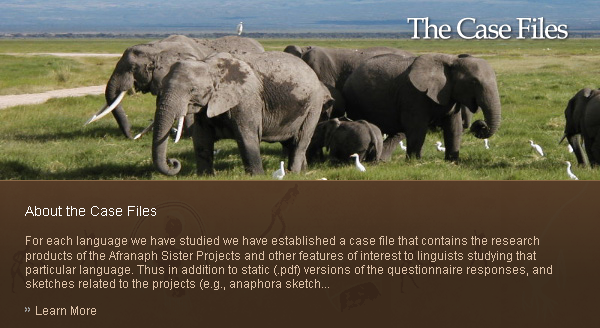- Last Updated on Friday, 08 September 2017 11:46
Sample Searches
For each of the searches defined below you are given a recipe for finding a certain class of entities. You have to execute the searches yourself in the database. While these are designed to help you with basic proficiency in defining searches, it is another matter to have a research question which guides your interest in defining a search. For those who want to see how searches driven by a research program can yield results interesting for theorists, see Safir (2016), which is also available here as Afranaph Technical Report #11
Sample Search 1: Suppose that you are not particularly interested in the research questions explored by the specialized portals, but you are interested in the distribution of causative morphology by verb type, e.g, whether or psych verbs can or must be causativized. To find every sentence in the database that has a CAUS morpheme and a psych verb,
Choose the Generic Portal
Choose Search
Define entity search as ‘Sentence’
Open the ‘Sentence’ dropdown
On the gloss line enter CAUS
Under ‘Semantic verb class’ select ‘psych verb’
Search
On 08/25/2016, this search returns 104 sentences from 14 languages. You may not find sentences that exactly serve your research interests, but you may be able to determine which languages would be good ones to know about in more detail. It is possible that Afranaph will be able to help you find more examples closer to your research interest through contact with our consultants.
Sample Search 2: Suppose that you are interested in contexts where anaphora for a single argument is achieved by more than one marker, that is, where two anaphoric markers work in combination to achieve a reading where a single argument is bound by another argument. Perhaps you are interested in doubling phenomena, which this might be an instance of. The Anaphora Portal defines combination markers as markers that can be used independently, but in certain contexts are used together to achieve readings of this type. If you want to find all the languages that have combination marker phenomena, then search as follows:
Open the Anaphora Portal
Define the search entity as ‘Language’
Open the dropdown for ‘Anaphoric Marker’
Under ‘Exponent complexity type’, click on ‘combination marker’
Click on ‘Search’
The set of languages that have combination anaphoric markers will appear. If you want instead to see the list of anaphoric markers of this type, then click on ‘back to search’, where your search settings are preserved, and change your entity search to ‘anaphoric marker’. If you want to limit your search to one language, certain specific languages, or one language family, these parameters can be defined for your search by opening the ‘Language’ dropdown.
Sample Search 3: Suppose you are interested in subjunctive clause types, that is, clause types that are inherently subjunctive. The property of being ‘subjunctive’ is defined very broadly (but in a way that empirically distinguishes indicatives and infinitives) in the DPAG for predicate types with respect to the following question: Does the predicate take inherently subjunctive complements? To find all the languages that have subjunctive clauses, proceed in one of two ways:
Set search entity as ‘Language’
Open ‘Predicate Type’ dropdown
Under ‘Are subjunctive complements possible with this predicate’, select ‘subjunctive compatible’.
Click ‘Search’.
This will only provide a list of the languages for which predicate properties have been analyzed and entered, so this will vastly under-report the set of languages in the database that have inherently subjunctive clauses, but you will not then have to look at the languages which have not been analyzed.
To get all of the languages in the AD that have SBJV clauses:
Set search entity as ‘Language’
Open Sentence dropdown
On the gloss line, enter the gloss SBJV
Caveat: This will get you all of the languages that have sentences glossed with subjunctive, but if clauses that are subjunctive in a language have no marker that is glossed SBJV, but perhaps have only irrealis marking, then those languages will not show up. Thus neither search is perfect, but each contributes, within the limits of how much analysis the database contains at a given point in time.
Sample Search 4: Suppose you are interested in complementizer agreement and you want to (a) find all the languages in the AD where complementizer agreement is found, (b) you want to look at the sentences in some of the languages that have complementizer agreement, and (c) you want to see if semantic properties of predicate type correlate with whether or not the complement clause has an agreeing complementizer.
Open the CC Portal and click on Search
(a) Define search for ‘Language’
Open C-type dropdown
Under ‘What does the C-type agree with?’ select ‘C-type agrees with a partner’
Search
(b) Define search for ‘Sentence’
Select languages you are interested in or language family (e.g., Niger-Congo)
Open C-type dropdown
Under ‘What does the C-type agree with?’ select ‘C-type agrees with a partner’
Search
(c) Define search for ‘Predicate Types’
Select semantic properties, e.g., under ‘Indicate which of the classes…’, select ‘epistemic
predicate., or under ‘What Aktionsart…’, select ‘achievement’, or select both, etc.
In the best case, all of these searches will produce non-null results, but the success of these searches is very dependent on how much information has been entered about the languages you are searching for. For example, if not all the sentences in a particular language have their full sentence properties entered, then search (a-b) will vastly under-report what can be found in the AD, and this is not an uncommon situation. The same is true for incomplete data entry for any other entity, including predicate types. We hope that by the time you are using the database many of these inadequacies will be addressed, at least for the languages that a given project has collected sentences for.






